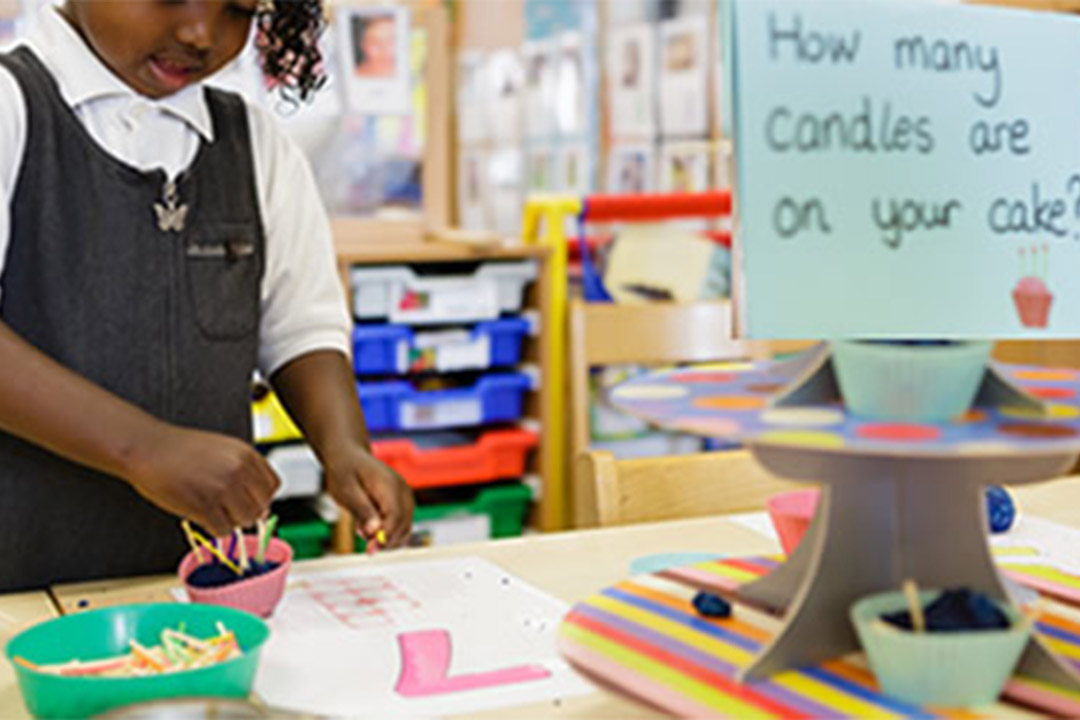Cardinality and Counting
Understanding that the cardinal value of a number refers to the quantity, or ‘howmanyness’ of things it represents

The cardinal value of a number refers to the quantity of things it represents, e.g. the numerosity, ‘howmanyness’, or ‘threeness’ of three. When children understand the cardinality of numbers, they know what the numbers mean in terms of knowing how many things they refer to. Counting is one way of establishing how many things are in a group, because the last number you say tells you how many there are. Children enjoy learning the sequence of counting numbers long before they understand the cardinal values of the numbers. Subitising is another way of recognising how many there are, without counting.
Typical progression of key ideas in this concept
Children need to know number names, initially to five, then ten, and extending to larger numbers, including crossing boundaries 19/20 and 29/30.
Counting back is a useful skill, but young children will find this harder because of the demand this places on the working memory.
Activities and opportunities:
- counting backwards, for example number rhymes
- starting from different numbers.
Children need lots of opportunities to count things in irregular arrangements. For example, how many play people are in the sandpit? How many cars have we got in the garage? These opportunities can also include counting things that cannot be seen, touched or moved.
Activities and opportunities:
- counting things of different sizes – this helps children to focus on the numerosity of the count
- counting things that can’t be seen, such as sounds, actions, words
- counting things that cannot be moved, such as pictures on a screen, birds at the bird table, faces on a shape.
Children need the opportunity to count out or ‘give’ a number of things from a larger group, not just to count the number that are there. This is to support them in focusing on the ‘stopping number’ which gives the cardinal value.
Activities and opportunities:
- playing dice games to collect a number of things
- playing track games and counting along the track.
Subitising is recognising how many things are in a group without having to count them one by one. Children need opportunities to see regular arrangements of small quantities, e.g. a dice face, structured manipulatives, etc., and be encouraged to say the quantity represented. Children also need opportunities to recognise small amounts (up to five) when they are not in the ‘regular’ arrangement, e.g. small handfuls of objects.
Activities and opportunities:
- using dot cards, dominoes and dice as part of a game, including irregularly arranged dots (e.g. stuck on)
- playing hidden objects games where objects are revealed for a few seconds, for example, small toys hidden under a bowl – shuffle them, lift the bowl briefly and ask how many there were
- ‘all at once fingers’ – show me four fingers.
Children need to have the opportunity to match a number symbol with a number of things. Look for opportunities to have a range of number symbols available, e.g. wooden numerals, calculators, handwritten - include different examples of a number:
 |
 |
 |
 |
Activities and opportunities:
- using numeral dice in games; matching numerals with varied groups of things
- using ‘tidy-up labels’ on containers and checking that nothing is missing
- reading number books
- putting the right number of snacks on a tray for the number of children shown on a card.
Children need the opportunity to recognise amounts that have been rearranged and to generalise that, if nothing has been added or taken away, then the amount is the same.
Activities and opportunities:
- correcting a puppet who may say that there are more or fewer objects now, as they have been moved around, e.g. spread out or pushed together
- contexts such as sharing things out (grouping them in different ways) and then the puppet complaining that it is not fair as they have less
- encourage the children to make different patterns with a given number of things.
- missing out an object or counting an object twice
- when asked how many cars are in a group of four, simply recounting ‘1, 2, 3, 4,’ without concluding that ‘there are four cars in the group’
- when asked to ‘get five oranges’ from a trayful, a child just grabs some, or carries on counting past five
- when objects in a group are rearranged, the child (unnecessarily) recounts them to find how many there are
- difficulties in counting back
- confusion over the 'teen' numbers – they are hard to learn
- missing a number like 15 (13 or 15 are commonly missed out) or confusing ‘thirteen’ and ‘thirty’.
Can a child:
- consistently recite the correct sequence of numbers and cross decade boundaries?
- collect nine from a large pile, e.g. nine pencils from a pot?
- subitise (instantly recognise) a group that contains up to four, then five, in a range of ways, e.g. fingers, dice, random arrangement?
- select a numeral to represent a quantity in a range of fonts, e.g.
,
?
- correct a puppet who thinks the amount has changed when their collection has been rearranged?
Image credits
4 (1) by Ghost Presenter (adapted)
4 (2) by Makarios Tang (adapted)
4 (3) by HENCETHEBOOM (adapted)
4 (4) by Marvin Ronsdorf (adapted)
All in the public domain